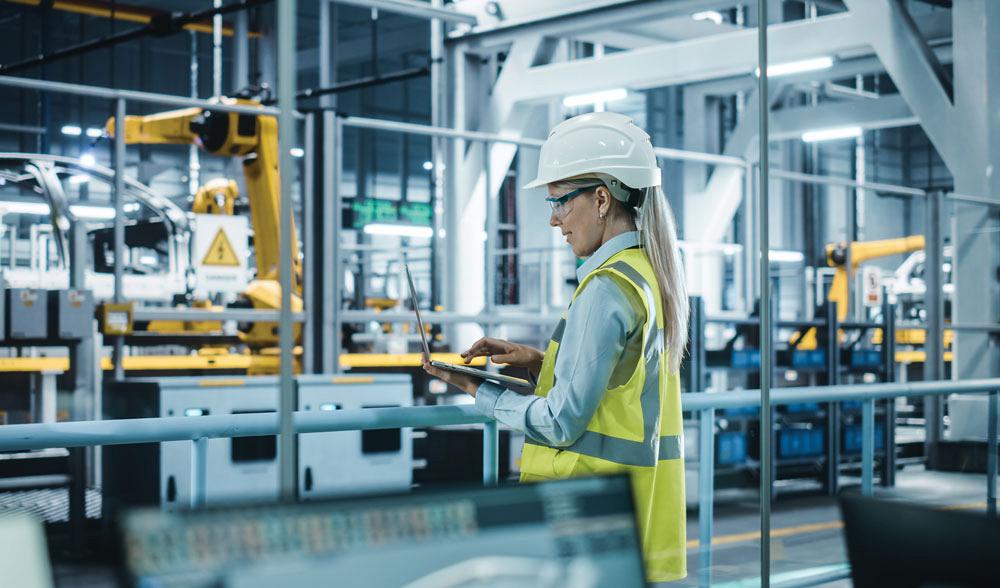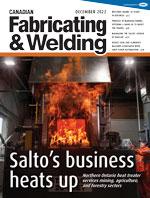machinery safety consultant and training advisor
- FMA
- The Fabricator
- FABTECH
- Canadian Metalworking
Develop a culture of safety
Reduce risk and eliminate hazards associated with shop floor automation
- By João Paulo Vaz
- December 26, 2022
- Article
- Automation and Software

Guards serve as a physical barrier to impede access to moving parts of the machine. gorodenkoff/iStock/Getty Images Plus
Automated machinery and equipment should be designed to perform tasks quickly and precisely, with little to no human intervention, to prevent injuries. On the shop floor, however, that is not always possible.
With the current state of the art in the field of industrial automation, machines perform tasks exactly as they are designed and programed to do. Machines are not yet self-aware and the only ”sense” they have come from the sensors we fit them with. Therefore, appropriate safety measures need to be applied to reduce the risks to an acceptable level, and operators must be trained in safe practices. Some common hazards can arise without these safety measures:
- Unexpected startup
- Unauthorized access to hazardous parts of the machine
- Missing or flimsy guards
- Fixed guards missing one or more fasteners or with fasteners that can be removed by hand
- Safeguards that can be easily bypassed
- Insufficient safety distance between the hazard zone and safeguards
- Safeguards that allow access by reaching over, under, and around
- Inadequate maintenance of dangerous electrical parts
- Safety functions performed by inadequate components or technologies
Risk Reduction
A safe machine starts with a comprehensive risk assessment at the design stage. One of the good practices recommended by CSA Z432-16, Safeguarding of Machinery, is the appropriate identification of sources of hazards and hazardous situations in a risk assessment, including, among others, the physical and cognitive interaction of the worker with the machine.
Risk reduction can be achieved by the elimination of hazards, or by separately or simultaneously reducing the two main elements that determine the associated risk: the severity of harm from the hazard under consideration and the probability of occurrence of that harm.
Clause 6 of CSA Z432-1 recommends a three-step hierarchy for the adoption of risk reduction measures:
- Inherently safe design
- Safeguarding and complementary protective devices
- Administrative controls and other protective measures.
The purpose of the three-step hierarchy is to identify the individual or combination of preventive or protective measures that provide the highest degree of reliability to achieve effective risk control. It is also very important to avoid introducing new hazards when adopting protective measures, such as a guard designed that could fall on the operator’s hands. Training, experience, and ability must not be used as a substitute for hazard elimination, risk control by design, or safeguarding where such protective measures can be practicably implemented.
Human Interaction Points
Annex F of CSA Z432-16 also introduces the concept of human performance and how this concept can be applied to safe working practices for the operation and maintenance of machinery. The following are basic principles of human performance:
- People are fallible, and even the best people make mistakes.
- Error-likely situations and conditions are predictable, manageable, and preventable.
- Individual performance is influenced by organizational processes and values.
- People achieve high levels of performance largely because of the encouragement and reinforcement received from leaders, peers, and subordinates.
- Incidents can be avoided through an understanding of how mistakes occur, and application of the lessons learned from past incidents.
Both machine manufacturers and employers need competent professionals to tackle both the environmental and human-related safety aspects.
Safeguarding Options
Safeguards protect persons from hazards that cannot be removed or designed out, such as moving parts of the machine. Guards can provide a barrier for overall physical protection, but they also can be used to contain noise, hazardous substances, and certain types of radiation. ISO 14120:2015, Safety of Machinery—Guards, gives general requirements for the design and construction of fixed and movable guards.
Some applications may require workers to access hazard points on the machine. This may be part of normal operations, such as feeding the machine with parts, tool changing, setup, or maintenance. In these cases, a fixed guard alone may not be the best option.

Appropriate safety measures need to be applied to reduce risks to an acceptable level, and operators must be trained in safe practices. vm/E+
ISO 14120 recommends the use of a fixed guard only if access is needed infrequently, such as less than once per week; its replacement is easy; and its removal and replacement are carried out under a safe system of work, such as lockout/tagout. Otherwise, the designer may select moveable guards (with or without guard-locking, depending on the machine’s overall stopping time).
In other applications, guards may not be practical, especially when access to the hazard zone is constant. In these cases, the designer might want to equip the machine with protective devices, such as two-hand controls, light curtains, and laser scanners.
There is no particular formula or flowchart to determine what safeguard a machine designer must use for a particular application. Based on the risk assessment of the machine and experience of use, the designer must determine the contribution to risk reduction that needs to be provided by each safeguard.
João Paulo Vaz is a machinery safety consultant and training advisor for Pilz Automation Safety Canada, 6695 Millcreek Dr, Unit 8, Mississauga, ON L5N 5R8, www.pilz.ca.
About the Author
subscribe now


Keep up to date with the latest news, events, and technology for all things metal from our pair of monthly magazines written specifically for Canadian manufacturers!
Start Your Free Subscription- Industry Events
MME Saskatoon
- May 28, 2024
- Saskatoon, SK Canada
CME's Health & Safety Symposium for Manufacturers
- May 29, 2024
- Mississauga, ON Canada
DiPaolo Machine Tools Open House 2024
- June 4 - 5, 2024
- Mississauga, ON Canada
FABTECH Canada
- June 11 - 13, 2024
- Toronto, ON Canada
Zoller Open House & Technology Days 2024
- June 12 - 13, 2024
- Ann Arbor, MI





















